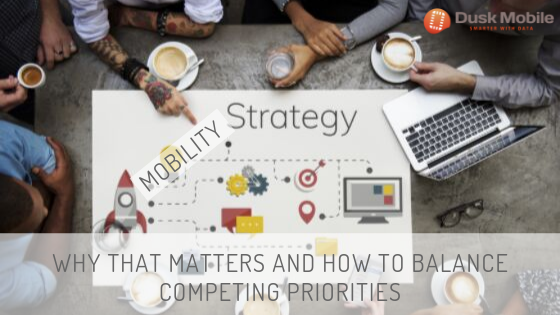
5 reasons to formulate a mobility strategy for your business
Strategies span the length and breadth of your businesses, short and long term, dependent strategies and strategies within strategies to name just a few. The fine balance between defining and executing a strategy but remaining nimble enough to keep pace with the rapidly evolving landscape of today, has become all the more challenging in recent years, especially with mobility.
We know mobility and started when mobility was a single device in the whole business, usually with the CEO. We are seeing a number of drivers in the market today when spending time with our customers developing their mobility strategy.
1. Address tactical needs and strategic needs
These include shorter or more immediate priorities such as new contracts being won, end of life hardware or software, security items or defects with current mobility products. These all require more rapid remedies and need addressing in weeks or months, not years.
Longer term strategies that balance infrastructure investment, architectural decisions along with core system refreshes can be years from putting business case to go live. While crucial in long term planning for your business, putting all your eggs in this basket creates a number of challenges around enablement, serviceability and compliance.
There is certainly more rapid enablement that can occur once your business is cloud first. However, the “journey to the cloud” can often be found as part of the broader technology strategy.
Our approach to balancing these two priorities considers a number of inputs and involves working closely across business and IT. In essence any tactical decision should address short term needs that don’t derail a strategy but provide a tactical input to a longer-term strategy. Considerations include:
- Unwinding tactical technology decisions – this could be as simple as data migration planning, leasing of equipment structured in such a way it can be returned or upgraded
- Managing technical debt and scope in the knowledge the decision is short term.
- Partnering with a vendor(s) who can grow from a tactical solution provider to a strategic solution provider
2. Strengthen or in some cases rebuild IT & business relationships
There are many reasons we regularly see for relationships between business and IT not being as strong as perhaps they should be. A mobility strategy is an opportune time to bring the staff at the coal face together with the technology enablers in IT. Through discovery workshops, interviews and time in the field, we have seen this relationship rebuilt.
Engagement between teams within the 4 walls of the business is critical and a mobility strategy provides opportunity to get everyone on the bus.
Our suggestion would be to, consider moving the relationship from a project basis or “as needs” to a product-based relationship with business partners. Having regular reviews and working sessions ensures the momentum is maintained and the opportunity to address items is provided through scheduled regular meetings. Every business is different but at a minimum monthly, perhaps even weekly.
3. Capability gaps
This area spans multiple fronts, including but not limited to:
- Legacy back office systems
- Data structures, integrity and security
- Specialist skills both technically and in change
- Poorly built existing mobile tools
- Deprecated existing mobile capability
Your back office Enterprise Asset Management (EAM) systems, Enterprise Resource Planning (ERP) solutions, Geospatial Information Systems (GIS) and other core business systems have been around far longer than mobility. The skills used to implement these systems have long left your business or connecting to these systems can seem insurmountable.
We undertake a gap analysis based on the information the business requires to do their job on mobile, the location of that information in the business and the capability required to join the dots. Our suggestion is to partner with a company who has access to secure integration tools and capability ensuring these capability gaps can be closed.
4. Engagement with industry leaders to be competitive but deliver the right outcome
The appetite of our customers for change varies in pace. Some are ready to move quickly, especially in the tactical mobility deliverables while others are looking for key inputs to their larger strategies and deferring change.
The phrase we hear is “We don’t know what we don’t know”. In many cases we find there is a simple, secure approach that addresses a tactical need delivering measurable returns.
5. Outlining a common goal to work towards
Each industry has its own specific requirements when it comes to a mobility strategy and some underlining commonality. A mobility strategy shares many components of a traditional business strategy. The following stages are from the the Saylor Academy website on International Business Strategy.
1. Arenas – Where will we be active?
What areas of the business require mobility, what timeframes and why?
2. Differentiators – How will we get there?
Using mobility as a differentiator with competition, driving efficiencies through the business and more.
3. Vehicles – How will we win in the marketplace?
Determining which technologies and tools are best, based on business needs for mobility.
4. Staging – What will be our speed and sequence of moves?
A mobility strategy needs to align with a business strategy but also consider short and long term needs
5. Economic logic – How will we obtain our returns?
Measuring the benefits and ROI of implementing a mobility strategy. Spanning more than just financial but into customer service and other operational efficiencies.
Other References
Your Strategy Needs A Strategy – Martin Reeves, Knut Haanaes, Janmejaya Sinha
Takeaway Tip
So how do you get started? Speak to the team at Dusk about our self assessment mobility maturity framework that is part of our fixed outcome mobility strategy engagements. You can find more on this page.
The Dusk Mobile Intelligent Operations Platform connects your staff on any device, any time and in any location. Integrate your favourite products quickly and easily for real time collaboration and task management amongst your teams. Automating work functions and delivering a connected experience has never been easier and achieving productivity improvements can start tomorrow.
If you’d like to find out more on consistent messaging, visibility, workflows, automation with project management and easy integration for your teams or business, get in touch today with our friendly team.
Any questions: Our community is here to help in the Support & Updates area!
Try a 14 day free trial of our Intelligent Operations Platform and start seeing the benefits of automated workflows, informed decision making and a single, comprehensive view of your business in real time. Start collaborating today.
Start your free trial today
Not sure where to start? Request a demo from our team via the link:
Request a Demo
Or you just have some questions:



